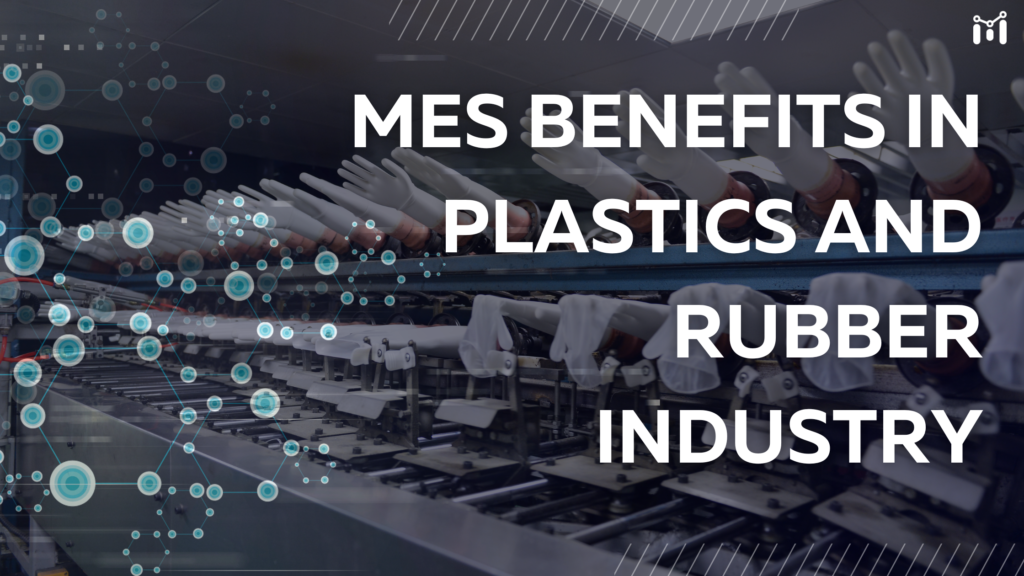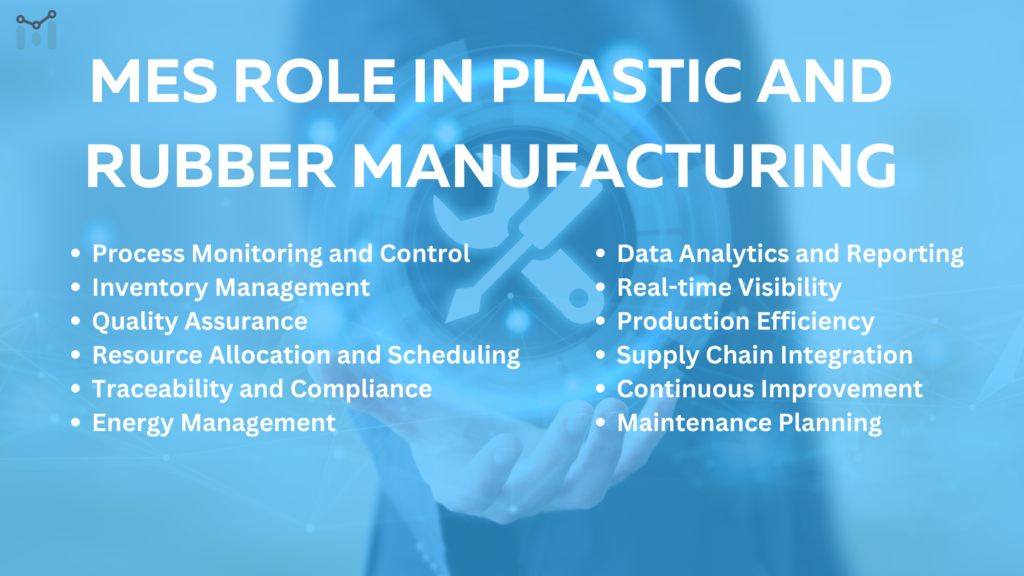MES Benefits in Rubber and Plastic Industry

In today’s dynamic manufacturing landscape, the plastics and rubber industry stands at the forefront of innovation and versatility. These industries have witnessed remarkable growth, owing to their indispensable role in countless sectors, from automotive and construction to healthcare and consumer goods. However, with this growth comes a heightened need for precision, efficiency, and quality control. This is where Manufacturing Execution Systems (MES) emerge as the catalysts for transformation. MES, equipped with real-time monitoring, data analytics, and process optimization capabilities, have become the secret weapon of plastics and rubber manufacturers. In this blog, we dive deep into the fascinating world of MES and explore how these systems are revolutionizing the plastics and rubber industry, unlocking new horizons of productivity, sustainability, and excellence.
Manufacturing Process followed by Plastic and Rubber Industry
Plastics Manufacturing Process:
Raw Material Preparation:
Plastics manufacturing begins with the selection and preparation of raw materials, such as polymers (e.g., polyethylene, polypropylene) and additives (e.g., colorants, stabilizers).
Polymerization:
Some plastics are created through polymerization processes, where monomers are chemically bonded together to form long polymer chains.
Compounding:
Additives and modifiers are mixed with the polymer to enhance its properties, such as strength, color, and flame resistance.
Extrusion:
The polymer compound is melted and forced through a die to create a continuous profile or shape. This process is commonly used for producing plastic sheets, films, pipes, and profiles.
Injection Molding:
Molten plastic is injected into a mold cavity under high pressure to create intricate shapes and complex parts, commonly used for products like plastic bottles, toys, and automotive components.
Blow Molding:
Air pressure is used to expand a hollow parison (a heated plastic tube) inside a mold, creating products like plastic containers, bottles, and tanks.
Thermoforming:
Sheets of plastic are heated and molded into specific shapes using vacuum or pressure. It is used for products like packaging trays and disposable cups.
Compression Molding:
A preheated plastic material is placed into a mold cavity, and pressure is applied to create products like electrical connectors and automotive parts.
Finishing and Assembly:
After the primary shaping process, plastics may undergo secondary processes like machining, welding, or assembly to complete the final product.
Rubber Manufacturing Process:
Raw Material Preparation:
Rubber manufacturing begins with the preparation of natural or synthetic rubber compounds. Additives like sulfur, accelerators, and fillers are mixed with rubber to achieve desired properties.
Mastication:
The rubber compound is mechanically worked to break down polymer chains, improving processability and dispersion of additives.
Shaping:
Rubber can be shaped into various forms using processes like extrusion, compression molding, and injection molding, depending on the intended product.
Vulcanization:
Vulcanization is a critical step where rubber is heated with sulfur to cross-link polymer chains. This process imparts elasticity and durability to the rubber.
Calendering:
Rubber sheets or films are produced by passing the rubber compound between rollers to achieve the desired thickness and smoothness.
Curing:
Shaped rubber products are cured in an oven or autoclave to complete the vulcanization process.
Finishing and Assembly:
After curing, rubber products may undergo finishing processes such as cutting, trimming, and assembly to meet specific requirements.
Testing and Quality Control:
Both plastics and rubber products undergo rigorous testing and quality control measures to ensure they meet industry standards and customer specifications.
These manufacturing processes in the plastics and rubber industries are highly versatile, allowing for the production of a wide range of products with diverse shapes, sizes, and properties to meet various industrial and consumer needs.
With reference to report from *Yahoo Finance The global plastics and rubber products market grew from $1365.01 billion in 2022 to $1466.92 billion in 2023 at a compound annual growth rate (CAGR) of 7.5%. The plastics and rubber products market is expected to grow to $1899.33 billion in 2027 at a CAGR of 6.7%.
The Role of MES in Plastics and Rubber Manufacturing
MES plays a crucial role in the plastics and rubber manufacturing industry like:

Process Monitoring and Control:
MES systems continuously monitor and control various stages of production, ensuring consistency and quality in plastics and rubber manufacturing.
Real-time data collection and analysis help identify deviations and make necessary adjustments to maintain product specifications.
MES tracks raw materials, semi-finished products, and finished goods in real-time, allowing for efficient inventory management.
It helps prevent overstocking or understocking of materials, reducing wastage and production delays.
Quality Assurance:
MES systems facilitate real-time quality control by monitoring critical parameters during production.
If any product falls out of specification, MES can trigger alarms and automatically adjust production parameters or halt the process, ensuring consistent product quality.
Resource Allocation and Scheduling:
MES helps in optimizing resource allocation by providing insights into machine and labor utilization.
It assists in scheduling production runs, reducing downtime, and maximizing operational efficiency.
Traceability and Compliance:
MES maintains comprehensive traceability records for materials, batches, and products.
This is crucial for tracking the source of any defects or recalls and ensuring compliance with industry regulations and standards.
Energy Management:
MES can monitor energy consumption within the manufacturing process, helping companies reduce energy costs and environmental impact.
It can schedule processes during off-peak hours to take advantage of lower energy rates.
Data Analytics and Reporting:
MES collects and stores data over time, enabling historical analysis and trend identification.
This data-driven approach helps in making informed decisions, optimizing processes, and predicting maintenance needs.
Real-time Visibility:
MES provides real-time visibility into production operations, allowing managers to track progress, identify bottlenecks, and respond to issues promptly.
Production Efficiency:
By streamlining processes, reducing downtime, and minimizing waste, MES systems enhance overall production efficiency, leading to cost savings.
Supply Chain Integration:
MES can integrate with other enterprise systems, such as Enterprise Resource Planning (ERP) and Customer Relationship Management (CRM), to provide end-to-end visibility and coordination in the supply chain.
Continuous Improvement:
MES facilitates continuous improvement initiatives by providing data-driven insights that enable manufacturers to refine processes, reduce defects, and enhance overall competitiveness.
Maintenance Planning:
Predictive maintenance capabilities within MES help in scheduling maintenance activities based on equipment condition, reducing unplanned downtime and ensuring optimal equipment performance.
In summary, MES systems are instrumental in plastics and rubber manufacturing by optimizing processes, ensuring quality, improving resource management, and enhancing overall operational efficiency while ensuring compliance with industry standards and regulations.
Apart from Rubber and Plastic Industry, MES also plays vital role in many other industries like Medical, you can check about the same in our blog The Power of Production Management Systems in Medical Equipment Sector. Kindly have a look into it.
How MES Helps Overcome Challenges in Plastics and Rubber Manufacturing
MES plays a crucial role in overcoming challenges in the plastics and rubber manufacturing industry.
- It addresses the complexity of managing diverse product portfolios, ensuring efficient operations at every level of the functional hierarchy.
- Additionally, MES mitigates risks associated with strict regulatory requirements, such as those imposed by the FDA and ANSI.
- With real-time visibility into supply chain and logistics challenges, MES enables decision-makers to make informed choices and optimize plant activities.
- Furthermore, it supports effective resource management and allocation, enabling organizations to utilize their workforce and equipment efficiently.
- MES also facilitates proactive problem-solving and continuous improvement, driving operational excellence.
Conclusion
In conclusion, Manufacturing Execution Systems (MES) play a crucial role in the plastics and rubber manufacturing industry. MES provides real-time visibility and control over the production process, leading to increased efficiency and productivity. By integrating data from various sources and automating workflows, MES helps manufacturers overcome challenges and optimize operations. A case study of a successful MES implementation highlights the tangible benefits that can be achieved. Looking ahead, the future of MES in plastics and rubber manufacturing holds promising trends and technologies. However, it is important to note that not all manufacturers are currently benefiting from MES. To stay competitive in the industry, companies must embrace these advanced systems and unlock their full potential.
